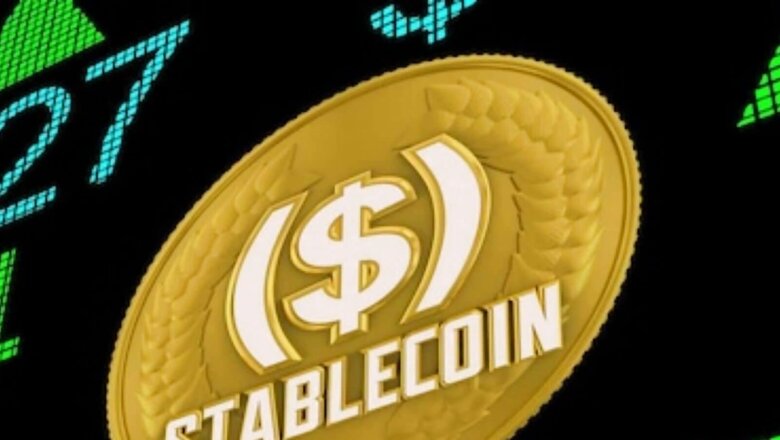
views
With the regulators ramping up their scrutiny around stablecoins, the white to the otherwise grey, rough and volatile cryptocurrency is in for some unstable times.
Post the Terra-Luna loss that shook the world and saw investors lose $40 billion, US lawmakers are contemplating imposing a two-year ban on algorithmic stablecoins such as TerraUSD. Crypto exchanges Binance, and closer home, WazirX, have delisted Circle, the second largest stablecoin by market cap, preventing any investor deposits in the coin. Globally, too, whales i.e significant holders, who constitute the top 1% of all crypto addresses, have been declining over the past few months.
Rajagopal Menon, Vice-President, WazirX, said: “Stablecoins inherently pose a unique dilemma for regulators in the US, and the world at large. On the one hand, they are a way of maintaining the dollar status as the world’s reserve currency as they peg to government-issued currencies such as the U.S. dollar. On the other hand, they pose an inherent financial risk.”
The move to delist Circle should just be seen as a measure to better liquidity and capital effectiveness on part of Binance, the largest crypto exchange in the world by trade volumes, said Punit Agarwal, Founder and CEO, KoinX.
However, Mahin Gupta, Founder of Liminal, thinks of it as a competitive move. “The USDC getting delisted is simply a business move by competitors, e.g. Binance, to promote its native stablecoins BUSD. Recently, Binance delisted various non-prominent coins like USDC, TUSD, etc. This move will help Binance promote its stablecoin. It will also help in concentrating more liquidity in one order book against several stablecoin trading pads. In addition, the stablecoin treasury is a yield-generating asset that adds to the revenue, so it is in the best interest of Binance to promote their stablecoins,” he said.
It augurs well for Binance, the issuer of the third largest stablecoin BUSD, which has a market cap of $20 billion. By effectively restricting USDC, whose market cap has now dropped to $49 billion on its platform, the only major competitor is Tether, whose current market cap is $67 billion.
But Agrawal thinks this move might turn out to be good for Circle as well.
“There are a lot of myths regarding the USDC delisting. Major exchanges announced that the existing USDC, USDP & TUSD balances in user accounts will be automatically converted to BUSD. Any new deposits of USDC, USDP & TUSD will also be converted into BUSD in the future. The change was meant to improve liquidity and capital efficiency. To be clear, major exchanges are not delisting USDC, only spot and future pairs are stopped.”
“Removing most of the stablecoin pairs simplifies the task of market makers and minimizes liquidity fragmentation. It also makes the user experience better as users no longer need to convert their USDC into BUSD or USDT each time they want to margin trade perps on the exchanges. Due to the restricted liquidity of BUSD outside major exchanges, customers have to convert the BUSD into USDC in order to use it in the other exchanges. This is advantageous for USDC as well,” he continued.
The largest stablecoin by market capitalization, Tether, is also under serious pressure. For long, Tether has claimed it is completely backed by US dollar, reinforcing some sense of calm into investors rattled by algo-stablecoins like TerraUSD. Such coins have no physical funds backing them.
Now, Tether will be required to produce documents to establish its USDT reserves, including account statements of banks and other institutions linked to its funds. According to CEO, Giottus Crypto Platform, “When glancing over the stablecoin segment in cryptocurrency, ignoring Tether (USDT) is impossible. Initially, it was promised that every Tether would be back 1-to-1 by traditional currency. That changed in 2019, when the company rephrased it to “100% backed by our reserves, including traditional currency.” Moreover, there is a mention of “including assets and receivables from loans made by Tether to third parties and affiliate entities”.
“That latter half stirred much controversy, as there has been wild speculation as to how the same people run Bitfinex and Tether. Making matters worse, Tether’s lawyers admitted in late 2019 that every Tether was only 74% backed. The company eventually settled a court case with the New York state. Moreover, the attorney general’s office concluded Tether has “no reserves to back the stable coins in circulation for periods of time”,” he noted.
However, he signed off noting that all these developments in the US crypto regulation space are at a nascent stage, and more details will be needed.
Read all the Latest Business News and Breaking News here


















Comments
0 comment